In 2024, selecting suitable coding languages in crafting a SaaS tech stack is crucial for any business or startup. It is the backbone, influencing a product's scalability, performance, and future adaptability. The choice of coding languages becomes a strategic decision, shaping the overall technology stack and affecting development processes.
Aloa, a full-service provider, aids businesses in navigating these challenges. Aloa ensures a tailored approach that aligns with the dynamics of SaaS product development. Their expertise spans various technologies, from web to mobile, offering a clear advantage in building the perfect tech stack for SaaS.
Previewing the blog, we delve into the top-rated coding languages for different aspects of a SaaS technology stack. From front-end technologies to back-end choices, we explore database technologies and server technologies. Afterward, you will gain insights into the optimal set of tools, empowering them to make informed decisions for their SaaS tech stack.
Let's get started!
8 Best Coding Languages for a SaaS Tech Stack
Selecting suitable coding languages in 2024 is crucial in crafting an effective SaaS tech stack. These languages are the foundation for determining the scalability, performance, and future adaptability of a software-as-a-service (SaaS) product. Coding languages are crucial to ensure seamless functionality and robust application performance.
Here, we present the top 8 coding languages essential for constructing a dynamic and effective SaaS technology stack.
Backend Development
Backend development involves building the server-side logic and databases that power web applications. It requires languages and frameworks optimized for performance, scalability, and data management.
Python
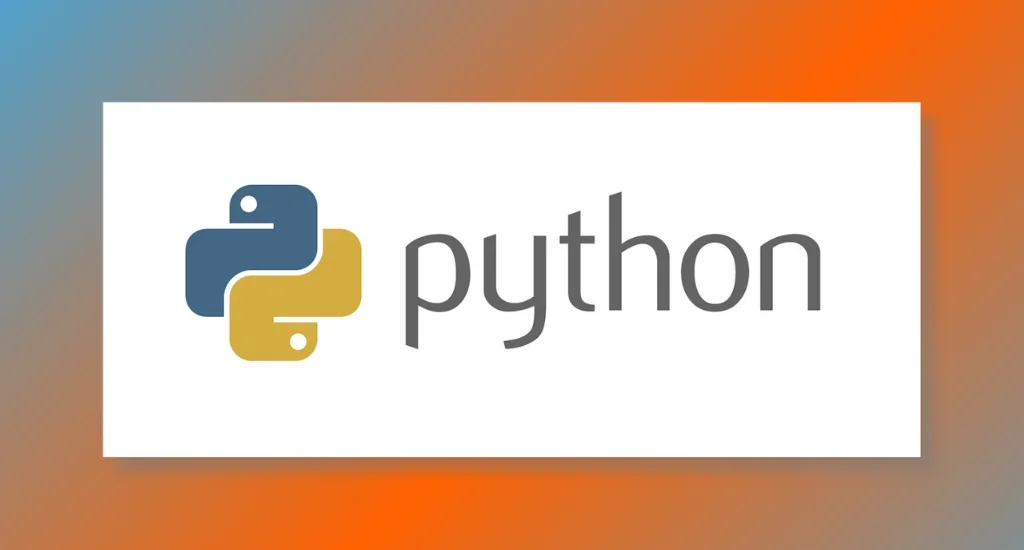
Python, a versatile and dynamically typed programming language, emerges as a cornerstone in the landscape of backend development for a SaaS tech stack. Its simplicity and readability make it an ideal choice for crafting scalable and efficient backend solutions, aligning with the dynamic requirements of modern SaaS applications.
Python's significance in SaaS technology stack development extends beyond its syntax. Leveraging Python for backend tasks yields numerous benefits crucial for ensuring the success of a SaaS product.
Notable Features of Using Python
- Readability and Simplicity: Python's clean syntax and straightforward structure enhance code readability, fostering collaboration and ease of maintenance within a SaaS technology stack.
- Versatility and Extensive Libraries: The language's versatility allows it to excel in various applications, while its rich set of libraries, including Django and Flask, provides developers with powerful tools for SaaS development.
- Community Support: Python boasts a thriving community, ensuring ongoing support, regular updates, and many resources for developers crafting a SaaS technology stack.
- Scalability: Python's scalability is paramount for evolving SaaS products, accommodating growth, and ensuring seamless performance as user bases expand.
- Integration Capabilities: Python seamlessly integrates with other languages and technologies, fostering interoperability within a diverse SaaS technology stack.
Consideration for Using Python
When constructing your SaaS technology stack, particularly for backend development, consider Python for its readability, versatility, scalability, and seamless integration capabilities. The extensive community support further solidifies Python's position as a reliable choice for achieving optimal performance and growth in the dynamic SaaS landscape.
Node.js (JavaScript)
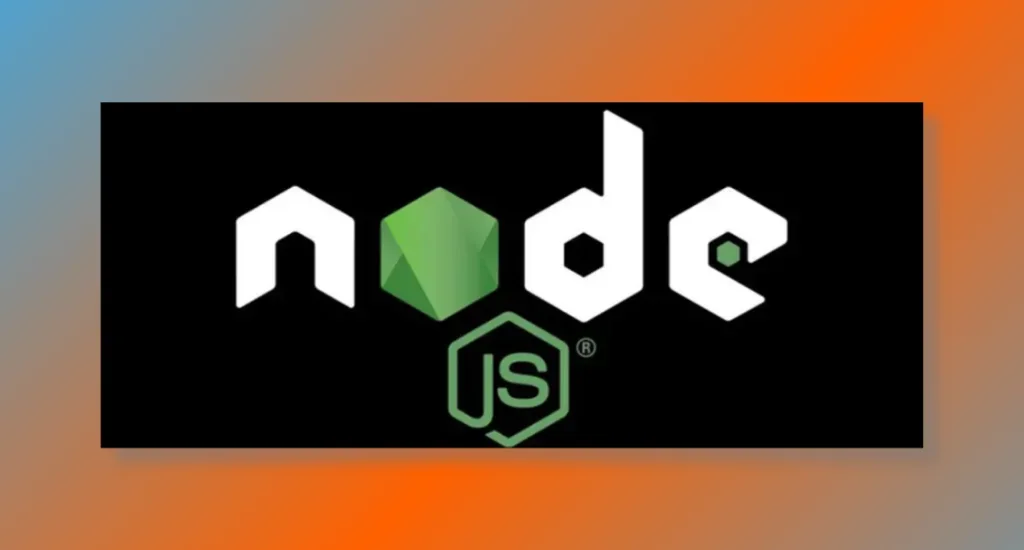
Node.js, an innovative runtime built on Chrome's V8 JavaScript engine, transforms backend development by allowing developers to use JavaScript for server-side scripting. This technology revolutionizes the traditional separation between frontend and backend, enabling a unified language—JavaScript—across the entire SaaS tech stack.
Node.js brings a paradigm shift to SaaS technology stack development, particularly in backend tasks. Leveraging JavaScript on the server side offers several key advantages essential for the success of modern SaaS applications.
Notable Features of Using Node.js (JavaScript)
- Single Language Across Stack: Node.js enables a seamless transition from frontend to backend with JavaScript, promoting consistency and reducing the learning curve for developers working on the entire SaaS technology stack.
- Event-Driven Architecture: The event-driven, non-blocking I/O model of Node.js ensures high concurrency, making it suitable for handling many simultaneous connections—a crucial aspect of scalable SaaS applications.
- Vibrant Ecosystem and NPM: Node.js leverages the Node Package Manager (NPM), offering a vast repository of ready-to-use packages. This accelerates development, reduces redundancy, and enhances the efficiency of building a SaaS technology stack.
- Real-time Capabilities: Node.js excels in real-time applications, making it ideal for features like chat applications and collaborative tools within the SaaS landscape.
- Community Support and Collaboration: The extensive JavaScript community, coupled with Node.js's popularity, ensures robust support, constant updates, and a collaborative environment—essential for maintaining a dynamic and evolving SaaS tech stack.
Consideration for Using Node.js (JavaScript)
When deliberating on your SaaS technology stack, especially in backend development, consider Node.js for its unified language approach, event-driven architecture, rich ecosystem, real-time capabilities, and strong community support. These features collectively position Node.js as a compelling choice for crafting scalable and responsive backend solutions in the ever-evolving SaaS landscape.
Frontend Development
Frontend development focuses on creating user interfaces that are visually appealing and responsive. It requires languages and frameworks for building dynamic and interactive web experiences.
JavaScript (React)
.webp)
JavaScript, especially with the React library, takes center stage in front-end development for a cutting-edge SaaS tech stack. JavaScript provides the interactivity and dynamic features crucial for delivering seamless user experiences, while React, a robust front-end framework, enhances the development of reusable and modular UI components.
Leveraging JavaScript, particularly with React, offers a plethora of advantages when crafting the frontend components of a SaaS technology stack. These benefits contribute to modern SaaS applications' agility, responsiveness, and user engagement.
Notable Features of Using JavaScript (React)
- Versatility and Cross-browser Compatibility: JavaScript's versatility allows developers to create interactive and dynamic features, ensuring a consistent user experience across different browsers and devices. React further streamlines this process by providing a component-based architecture.
- Efficient Development with Virtual DOM: React's Virtual DOM enhances frontend performance by minimizing the need for direct manipulation of the actual DOM, resulting in faster rendering and a smoother user interface.
- Reusability and Component-based Architecture: React promotes code reusability through its component-based architecture. It allows developers to create modular UI elements that can be easily reused across the application, facilitating efficient development and maintenance of a SaaS technology stack.
- Community and Ecosystem: JavaScript and React enjoy robust community support and a vast ecosystem of libraries and tools. This ensures continuous updates, bug fixes, and a wealth of resources for developers working on a SaaS technology stack.
- Single-page Application (SPA) Capabilities: JavaScript, in combination with React, facilitates the development of SPAs, enhancing user experience by providing seamless navigation without page reloads.
Consideration for Using JavaScript (React)
When contemplating the frontend development of your SaaS tech stack, consider JavaScript with React for its versatility, efficient development through Virtual DOM, reusability, strong community support, and the capability to build SPAs. Collectively, these features contribute to delivering a responsive and engaging user interface for your SaaS application.
Vue.js
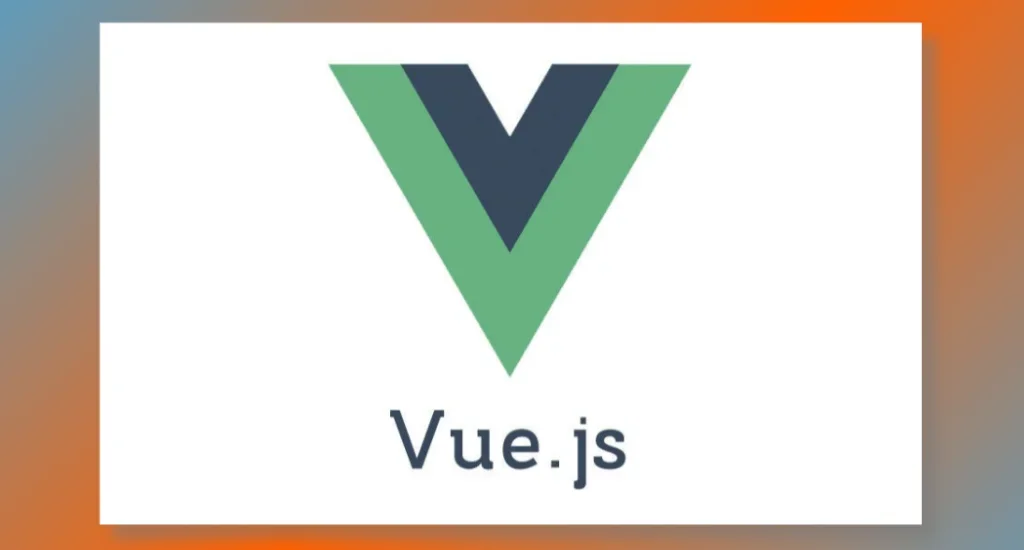
Vue.js, often called Vue, is a progressive JavaScript framework that excels in front-end development for a modern SaaS technology stack. Recognized for its simplicity and ease of integration, Vue.js empowers developers to build reactive user interfaces efficiently. Its flexibility and scalability make it a compelling choice for crafting dynamic and responsive applications.
Adopting Vue.js for the front end of a SaaS tech stack brings forth a range of advantages, contributing to creating intuitive and high-performance user interfaces.
Notable Features of Using Vue.js
- Ease of Integration: Vue.js is easily integrated with existing projects, allowing developers to adopt it gradually. This makes it suitable for enhancing specific components within a SaaS technology stack.
- Component-Based Architecture: Vue.js employs a component-based architecture, promoting code reusability and maintainability. This modular approach facilitates the development and scaling of front-end elements.
- Declarative Rendering: Vue.js uses a declarative rendering approach, making it easier for developers to understand and reason about the application's state and UI components.
- Flexibility and Progressive Framework: Vue.js is a progressive framework, meaning developers can use as much or as little of it as needed. This flexibility accommodates different project sizes and complexities within a SaaS technology stack.
- Reactivity and Two-Way Data Binding: Vue.js provides reactivity through a reactive data-binding system, ensuring that changes to the data are reflected in the UI instantly. Two-way data binding simplifies the synchronization between the model and the view.
Consideration for Using Vue.js
When contemplating the frontend development of your SaaS tech stack, Vue.js emerges as a strong contender, offering ease of integration, a component-based architecture, declarative rendering, flexibility, and reactivity. Whether enhancing existing components or building from scratch, Vue.js provides a versatile and efficient solution for creating modern and responsive user interfaces.
Infrastructure and Deployment
Infrastructure and deployment encompass setting up the server environment and automating deployment processes. It demands tools and platforms for scalability, reliability, and efficient resource management.
Docker and Kubernetes
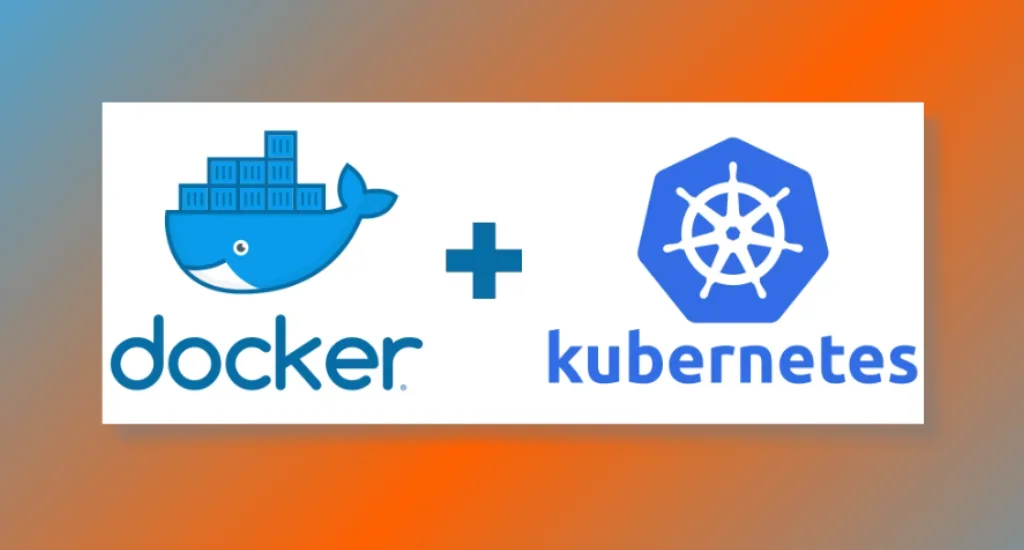
Docker is a containerization platform that encapsulates applications and their dependencies, ensuring consistency across various environments. On the other hand, Kubernetes is an orchestration tool that automates the deployment, scaling, and management of containerized applications.
Utilizing Docker and Kubernetes in your SaaS technology stack revolutionizes how applications are developed, deployed, and scaled. The symbiotic relationship between these technologies offers unparalleled advantages for streamlining the development lifecycle and enhancing the performance of SaaS applications.
Notable Features of Using Docker and Kubernetes
- Containerization for Efficiency: Docker's containerization simplifies packaging and deploying applications, ensuring consistency across development, testing, and production environments in a SaaS technology stack.
- Scalability and Load Balancing: Kubernetes excels in automating the scaling of applications, distributing workloads across containers, and efficiently managing resources to meet the demands of a growing SaaS user base.
- Isolation and Security: Docker containers provide isolated environments, enhancing container security by preventing application dependencies and conflicts. Kubernetes extends this security with robust access controls and network policies.
- Automation of Deployments: Docker and Kubernetes automate the deployment process, reducing manual errors and ensuring a seamless rollout of updates or new features in a SaaS tech stack.
- Resource Optimization: Kubernetes optimizes resource utilization, dynamically adjusting the allocation of CPU and memory to containers, ensuring efficient operation and cost-effectiveness in a SaaS environment.
Consideration for Using Docker and Kubernetes
When crafting the infrastructure and deployment aspect of your SaaS technology stack, consider the powerful combination of Docker and Kubernetes. Their containerization, scalability, security, automation, and resource optimization features synergize to elevate the efficiency and performance of your SaaS applications, fostering a seamless user experience and simplified development workflow.
Amazon Web Services (AWS)
.webp)
Amazon Web Services (AWS) is a comprehensive and widely adopted cloud computing platform that offers a plethora of services to facilitate scalable and flexible solutions. As a prominent player in the realm of infrastructure and deployment for a SaaS technology stack, AWS provides a robust foundation for hosting, storage, databases, machine learning, and more.
Leveraging Amazon Web Services (AWS) in your SaaS technology stack brings many advantages, revolutionizing how applications are developed, deployed, and scaled. AWS's extensive suite of services is designed to enhance performance, security, and scalability, making it a preferred choice for businesses of all sizes.
Notable Features of Using Amazon Web Services (AWS)
- Scalability and Flexibility: AWS provides elastic and scalable resources, allowing seamless adjustment to varying workloads and ensuring optimal performance for SaaS applications.
- Comprehensive Service Portfolio: The diverse range of AWS services includes computing power, storage, databases, analytics, machine learning, and more, offering a one-stop solution for the varied needs of a SaaS technology stack.
- Global Reach and Accessibility: With data centers strategically located around the globe, AWS ensures low-latency access and high availability, crucial for delivering a responsive user experience in a globalized SaaS landscape.
- Security and Compliance: AWS prioritizes security with robust measures, including encryption, access controls, and compliance certifications, instilling confidence in protecting sensitive data within a SaaS tech stack.
- Automation and DevOps Integration: AWS supports automation and integrates seamlessly with DevOps practices, facilitating efficient deployment, monitoring, and management of applications in a SaaS environment.
Consideration for Using Amazon Web Services (AWS)
When designing your SaaS technology stack's infrastructure and deployment layer, consider the comprehensive capabilities of Amazon Web Services (AWS). Its scalability, diverse service portfolio, global accessibility, security measures, and integration with DevOps practices make AWS an optimal choice for ensuring the success and resilience of your SaaS applications.
Data Storage and Databases
Data storage and databases involve managing structured or unstructured data efficiently. To support SaaS applications, databases must provide data consistency, reliability, and scalability.
MongoDB
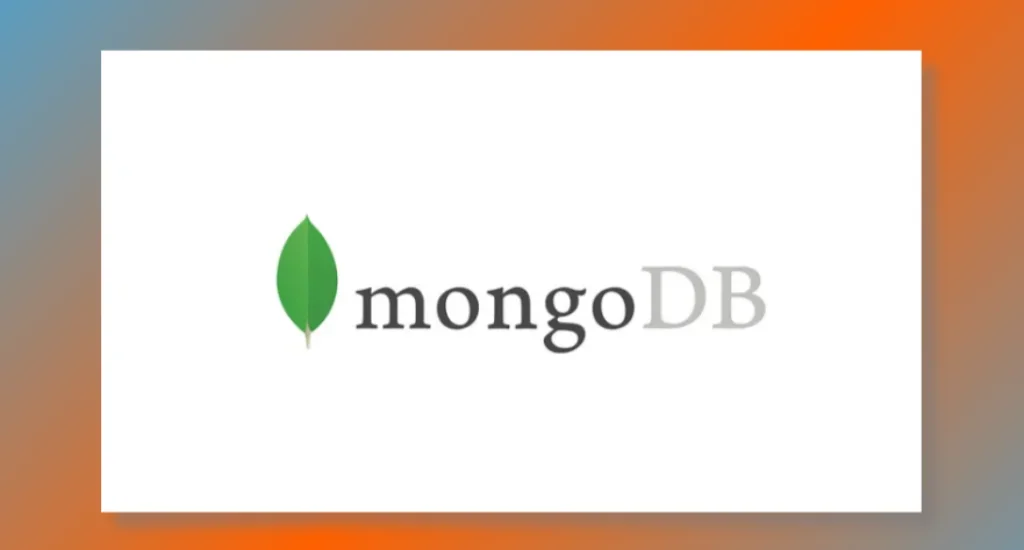
MongoDB, a leading NoSQL database, revolutionizes data management within a SaaS technology stack. It is designed to handle unstructured data efficiently, providing flexibility and scalability essential for modern applications. MongoDB's document-oriented model allows seamless integration with dynamic and evolving data structures.
MongoDB brings many advantages, making it a preferred choice for developers shaping the back end of their SaaS technology stack.
Notable Features of Using MongoDB:
- Flexible Schema Design: MongoDB's flexible schema accommodates evolving data models, allowing developers to iterate quickly and adapt to changing requirements in a dynamic SaaS tech stack.
- Horizontal Scalability: MongoDB supports horizontal scaling, distributing data across multiple servers for enhanced performance and capacity. This feature is crucial for meeting the growing demands of a scalable SaaS application.
- JSON-Like Documents: Storing data in BSON (Binary JSON) format, MongoDB's JSON-like documents facilitate seamless integration with programming languages, simplifying data manipulation within the SaaS technology stack.
- Aggregation Framework: MongoDB's robust aggregation framework enables complex data transformations and analytics within the database, reducing the need for extensive post-processing in the application layer of a SaaS solution.
- Geospatial Indexing: MongoDB excels in geospatial data handling, supporting geospatial indexes and queries. This is invaluable for location-based features within a SaaS technology stack, such as mapping and proximity-based searches.
Consideration for Using MongoDB
When crafting your SaaS technology stack's backend, MongoDB is an excellent choice, mainly if you prioritize flexible schema design, horizontal scalability, and efficient handling of unstructured data. Its support for geospatial indexing and powerful aggregation capabilities further position MongoDB as a versatile and robust database solution for your SaaS application.
PostgreSQL
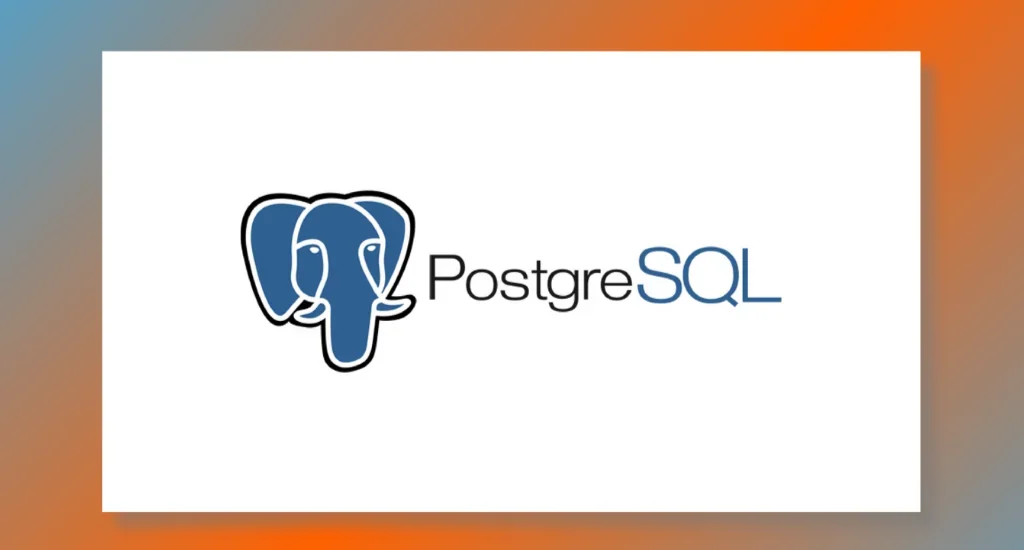
PostgreSQL, often hailed as the "world's most advanced open-source relational database," is a powerful choice for data storage within a SaaS technology stack. Renowned for its robustness and extensibility, PostgreSQL excels in managing structured data while providing advanced features for complex queries and transactions.
Integrating PostgreSQL into your SaaS tech stack unlocks many benefits, making it a formidable option for applications that demand a reliable and feature-rich relational database.
Notable Features of Using PostgreSQL
- Advanced SQL Support: PostgreSQL supports advanced SQL features, allowing developers to execute complex queries and join operations and transactions seamlessly within the SaaS technology stack.
- Extensibility and Customization: The extensibility of PostgreSQL permits the creation of custom data types, operators, and functions, catering to specific needs within a diverse SaaS application.
- Concurrency Control: PostgreSQL excels in managing concurrent transactions, providing strong support for multi-user environments, and ensuring data integrity in a busy SaaS technology stack.
- Scalability: With options for horizontal and vertical scaling, PostgreSQL adapts to the evolving demands of a SaaS application, ensuring performance and responsiveness even as user bases expand.
- Community Support and Security: PostgreSQL benefits from a robust community, offering continuous support, updates, and a focus on security. Its commitment to data integrity and security aligns with the stringent requirements of a SaaS technology stack.
Consideration for Using PostgreSQL
When selecting a relational database for your SaaS tech stack, PostgreSQL emerges as a strong contender, especially if you prioritize advanced SQL support, extensibility, and concurrency control. Its scalability and dedicated community support further solidify PostgreSQL as a reliable choice for managing structured data in the dynamic landscape of a SaaS application.
How To Choose the Best Language for Your SaaS Tech Stack
Selecting the right SaaS technology stack is pivotal for building scalable, efficient, and future-ready applications. Here are six crucial considerations to keep in mind when assembling your SaaS tech stack:
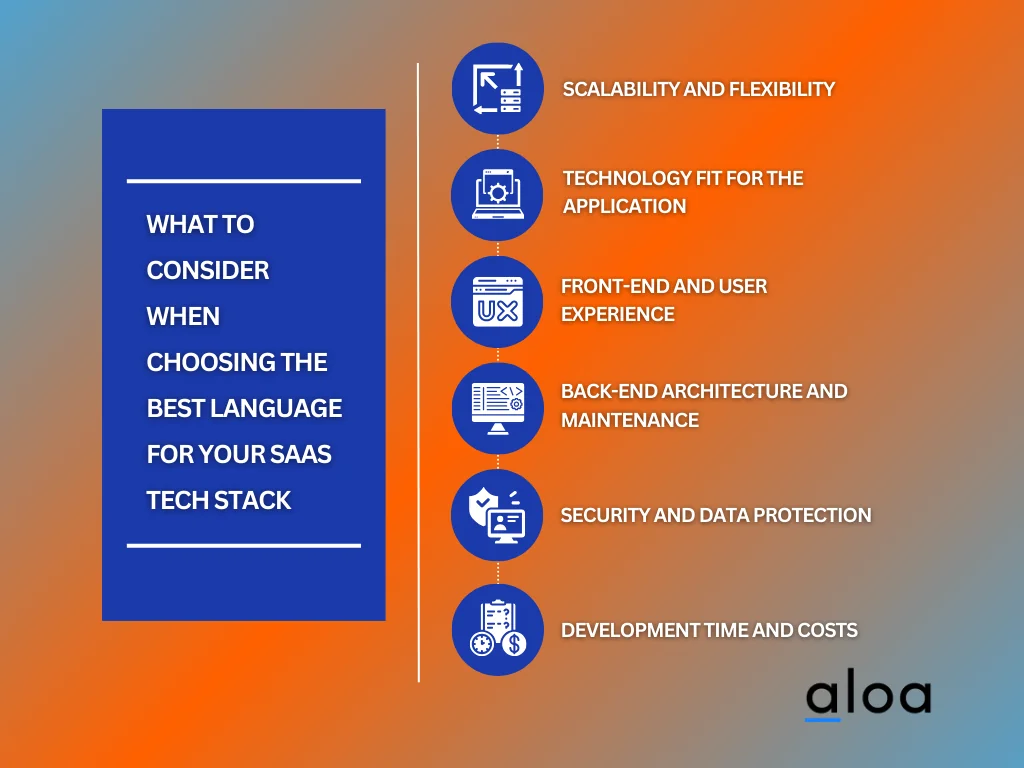
Scalability and Flexibility
Scalability stands as the cornerstone of a successful SaaS application. Your SaaS technology stack must accommodate increasing user loads and data volumes without compromising performance. Consider cloud services like Microsoft Azure, Google Cloud Platform, or Amazon Web Services (AWS) offering scalable infrastructure and services.
Technology Fit for the Application
Tailor your SaaS technology stack according to the application's specific needs. Assess whether a traditional relational database like Amazon RDS suits your data storage requirements or if a NoSQL database might offer more flexibility for unstructured data in a SaaS app.
Front-End and User Experience
A seamless user experience is critical. Choose front-end technologies like React Native or UI libraries to craft engaging interfaces and ensure device responsiveness. Focusing on style sheets and UI libraries enhances the look and feel of your web application.
Back-End Architecture and Maintenance
The back-end infrastructure determines the application's functionality and stability. Consider microservice architecture for scalability and maintenance ease. Evaluate cloud and web servers for reliability and cost-efficiency in handling SaaS application data and user interactions.
Security and Data Protection
Protecting user data is non-negotiable. Incorporate advanced security logic into your SaaS technology stack, including robust data security measures. Prioritize cloud solutions with stringent security protocols to safeguard user information.
Development Time and Costs
Development costs and time-to-market are crucial factors. Assess the learning curve of chosen programming languages or frameworks and their impact on development time. Consider continuous integration practices to streamline development and reduce maintenance costs in the long run.
Each consideration is pivotal in shaping a project's best SaaS technology stack. Whether prioritizing user experience, ensuring data security, or optimizing development costs, aligning the SaaS technology stack with your goals and objectives is pivotal for building a successful SaaS application.
Key Takeaway
In 2024, the SaaS tech stack will play a pivotal role in software development, emphasizing the significance of choosing suitable coding languages. A well-balanced tech stack, aligned with a SaaS product's specific needs and goals, is crucial for scalability and optimal performance. Whether front-end technologies drive the user interface, back-end languages handle core functionalities, or databases and servers manage data and content delivery, each component contributes to the application's overall success.
As the tech landscape evolves, staying informed about the best practices in SaaS development is imperative. The right tech stack ensures seamless functionality, facilitates the integration of additional features, and supports emerging technologies like machine learning and artificial intelligence. Whether you're developing a mobile application, a web page, or a software application, the code structure and languages chosen impact the user experience and overall efficiency.
For developers seeking a clear idea about the most important factors influencing a SaaS technology stack, this guide provides insights into the main components, event brokers, and the advanced logic required for contemporary software development. Connect with us at [email protected] to explore further and enhance your understanding of building a robust SaaS tech stack.

